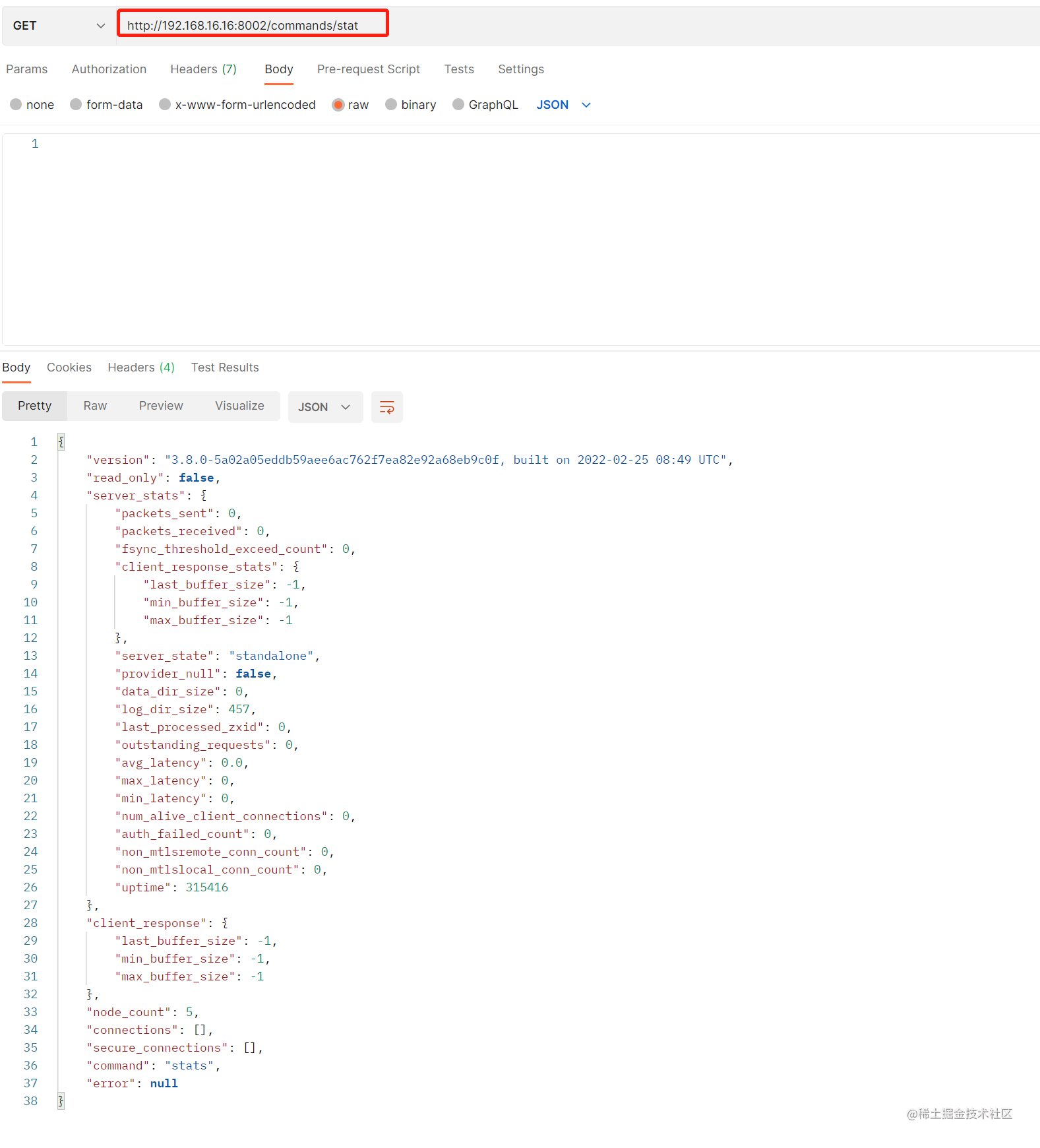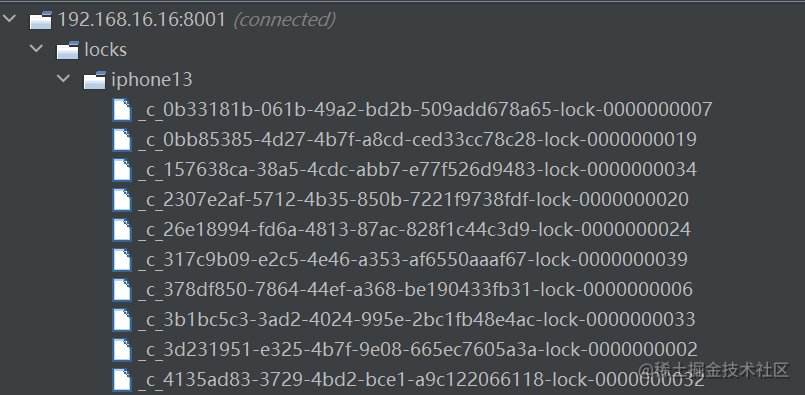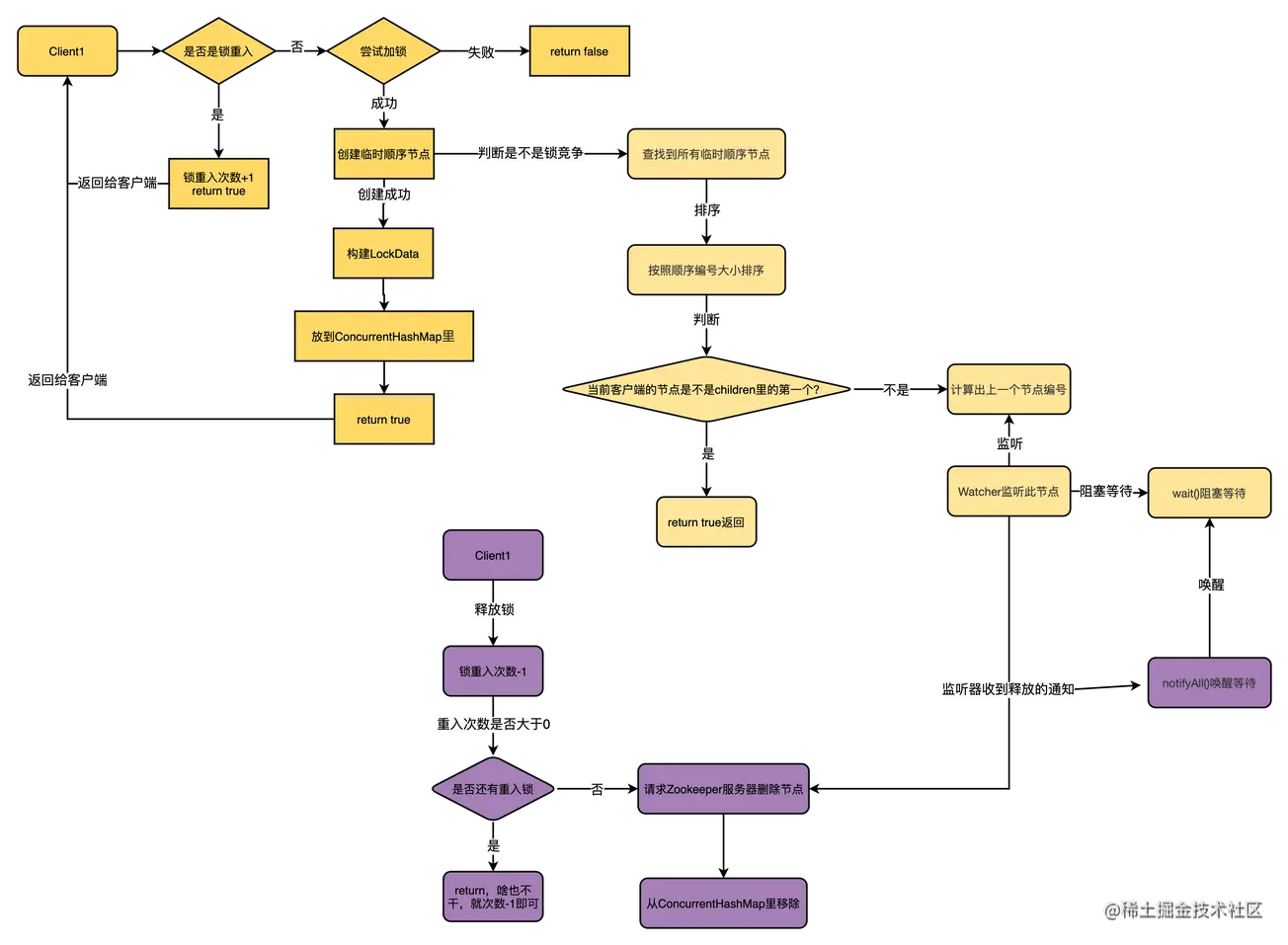现今服务大都是集群部署,使用操作系统锁或基于AQS的JUC并发工具,不能满足`跨JVM`线程同步的需求。本文从中间件安装开始,以抢购商品为例,实现一个`zk`分布式锁。
## 一、实现方式对比
分布式锁常见实现有如下三种:
- 数据库,基于唯一索引
- `redis`,基于原子命令与`lua`脚本
- `zookeeper`,基于临时顺序节点
我们选择zk实现的原因如下:
- `mysql`实现锁依赖IO,性能过低
- `redis`主从部署存在数据同步问题
- 实现`redLock`资源占用高、性能较低
- `zk`本身具有分布式一致性,`ZAB`协议请查阅参考资料
- `zk`实现较为简洁
- 生产环境本身已有`zk`集群
## 二、业务场景描述
假设我们要抢购一部新发行的手机,限制条件如下:
- 商品库存总量为`10`台
- 并发量大约为`10000`
- 不能超卖
## 三、中间件安装
- `docker`安装:
参考:[容器运行时docker与服务编排](https://juejin.cn/post/7083742011576025118)
- `zookeeper`安装
```
docker run ‐‐privileged=true ‐d ‐‐name zookeeper ‐p 8001:2181 ‐p 8002:8080 ‐d zookeeper:latest
```
这里宿主机端口映射,可自定义。
- 运行`docker ps`查看运行状态

- 防火墙开放端口
```
firewall‐cmd ‐‐zone=public ‐‐add‐port=2181/tcp ‐‐permanent
firewall‐cmd ‐‐zone=public ‐‐add‐port=8080/tcp ‐‐permanent
firewall‐cmd ‐‐reload
```
- 验证zookeeper

有返回状态即可。
## 四、代码实现
这里我们使用`curator`客户端进行实现。
- 引入依赖
```
<dependency>
<groupId>org.apache.curator</groupId>
<artifactId>curator-recipes</artifactId>
<version>5.2.0</version>
</dependency>
```
- 核心代码实现
```
@Component("zk")
public class FlashSaleHandler {
// 手机销售总量为10
public static AtomicInteger storageCount = new AtomicInteger(10);
public static final String SERVER_ADDR = "192.168.16.16:8001";
public Boolean flashSale() {
// 重试策略
RetryPolicy policy = new ExponentialBackoffRetry(2000, 3);
// 创建客户端
CuratorFramework client = CuratorFrameworkFactory.builder()
.namespace(String.valueOf(new Random().nextInt()))
.connectString(SERVER_ADDR)
.retryPolicy(policy)
.build();
// 连接zk服务端
client.start();
// 构建锁对象
final InterProcessMutex mutex = new InterProcessMutex(client, "/locks/iphone13");
// 秒杀逻辑
try {
// 获取锁
mutex.acquire();
// 秒杀减库存
if (storageCount.get() > 0) {
System.out.println(Thread.currentThread().getName()
+ "成功抢购,剩余库存" + storageCount.decrementAndGet());
return true;
} else {
// 库存不足
System.out.println("sold out...");
return false;
}
} catch (Exception exception) {
// 这里我们直接忽略
System.out.println("just ignore");
} finally {
// 释放锁
try {
mutex.release();
} catch (Exception exception) {
// 这里我们直接忽略
System.out.println("just ignore");
}
}
return false;
}
}
```
## 五、测试
测试线程池配置:
```
@Configuration
public class ThreadPoolCreator {
/**
* 核心线程数
*/
private static int corePoolSize = Runtime.getRuntime().availableProcessors() * 3;
/**
* 最大线程数 避免内存交换 设置为核心核心线程数
*/
private static int maximumPoolSize = corePoolSize;
/**
* 最大空闲时间
*/
private static long keepAliveTime = 3;
/**
* 最大空闲时间单位
*/
private static TimeUnit unit = TimeUnit.MINUTES;
/**
* 使用有界队列,避免内存溢出
*/
private static BlockingQueue<Runnable> workQueue = new LinkedBlockingDeque<>(10000);
/**
* 线程工厂,这里我们使用可命名的线程工厂,方便业务区分以及生产问题排查。
*/
private static ThreadFactory threadFactory = new ThreadFactoryBuilder()
.setNameFormat("flashSale-%d").build();
/**
* 拒绝策略 根据业务选择或者自定义
*/
private static RejectedExecutionHandler handler = new ThreadPoolExecutor.AbortPolicy();
@Bean
public ThreadPoolExecutor threadPoolExecutor(){
return new ThreadPoolExecutor(
corePoolSize,
maximumPoolSize,
keepAliveTime, unit,
workQueue,
threadFactory,
handler);
}
}
```
测试逻辑:
```
...
@Resource
private FlashSaleHandler zk;
@Test
public void testFlashSale(){
List<CompletableFuture<Boolean>> futures = new ArrayList<>(10000);
List<Boolean> results = new ArrayList<>(10000);
for (int i=0; i<10000; i++){
CompletableFuture<Boolean> future = CompletableFuture.supplyAsync(zk::flashSale,
threadPoolExecutor);
futures.add(future);
}
CompletableFuture
.allOf(futures.toArray(new CompletableFuture[futures.size()]))
.whenComplete((v, t)-> futures.forEach(eachFuture -> {
results.add(eachFuture.getNow(null));
})).join();
// 最终抢购成功数量为10
Assertions.assertEquals(results.stream()
.filter(result -> result == true).collect(Collectors.toList()).size(), 10);
}
```
运行单元测试,查看zookeeper节点情况与执行结果:


## 六、源码解析
本节我们从`mutex.acquire()`获取锁方法开始。
```
public void acquire() throws Exception {
if (!this.internalLock(-1L, (TimeUnit)null)) {
throw new IOException("Lost connection while trying to acquire lock: " + this.basePath);
}
}
```
我们进入`internalLock(...)`方法
```
private boolean internalLock(long time, TimeUnit unit) throws Exception {
// 获取当前线程
Thread currentThread = Thread.currentThread();
// 获取当前线程的lockData
InterProcessMutex.LockData lockData = (InterProcessMutex.LockData)this.threadData.get(currentThread);
if (lockData != null) {
// lockData不为空,说明当前线程已经加过锁,这里我们重入即可。
lockData.lockCount.incrementAndGet();
return true;
} else {
// lockData不为空,尝试枷锁,这里会返回一个临时顺序节点,我们这里是/locks/iphone13/...
String lockPath = this.internals.attemptLock(time, unit, this.getLockNodeBytes());
if (lockPath != null) {
// 加锁成功,构建lockData对象
InterProcessMutex.LockData newLockData = new InterProcessMutex.LockData(currentThread, lockPath);
this.threadData.put(currentThread, newLockData);
return true;
} else {
return false;
}
}
}
```
上面我们发现一直在操作一个`lockData`对象,我们来看看`lockData`中的内容:
```
private static class LockData {
final Thread owningThread;
final String lockPath;
final AtomicInteger lockCount;
...
}
```
我们可以看到该类主要包含三个属性:
- `owningThread` 代表锁所属的线程
- `lockPath` 表示临时顺序节点的路径
- `lockCount` 用于锁重入和解锁的计数器
我们接着看加锁方法`attemptLock(...)`:
```
String attemptLock(long time, TimeUnit unit, byte[] lockNodeBytes) throws Exception {
...
while(!isDone) {
isDone = true;
try {
// 创建锁
ourPath = this.driver.createsTheLock(this.client, this.path, localLockNodeBytes);
// 多个线程抢锁阻塞等待
hasTheLock = this.internalLockLoop(startMillis, millisToWait, ourPath);
} catch (NoNodeException var14) {
if (!this.client.getZookeeperClient().getRetryPolicy().allowRetry(retryCount++, System.currentTimeMillis() - startMillis, RetryLoop.getDefaultRetrySleeper())) {
throw var14;
}
isDone = false;
}
}
return hasTheLock ? ourPath : null;
}
```
先看下创建锁的方法`createsTheLock(...)`:
```
public String createsTheLock(CuratorFramework client, String path, byte[] lockNodeBytes) throws Exception {
String ourPath;
// 默认是null,这里我们跳过
if (lockNodeBytes != null) {
ourPath = (String)((ACLBackgroundPathAndBytesable)client.create().creatingParentContainersIfNeeded().withProtection().withMode(CreateMode.EPHEMERAL_SEQUENTIAL)).forPath(path, lockNodeBytes);
} else {
// 主要执行逻辑,创建节点
ourPath = (String)((ACLBackgroundPathAndBytesable)client.create().creatingParentContainersIfNeeded().withProtection().withMode(CreateMode.EPHEMERAL_SEQUENTIAL)).forPath(path);
}
return ourPath;
}
```
这里有一个节点类型的枚举:
```
PERSISTENT(0, false, false, false, false),
PERSISTENT_SEQUENTIAL(2, false, true, false, false),
EPHEMERAL(1, true, false, false, false),
EPHEMERAL_SEQUENTIAL(3, true, true, false, false),
CONTAINER(4, false, false, true, false),
PERSISTENT_WITH_TTL(5, false, false, false, true),
PERSISTENT_SEQUENTIAL_WITH_TTL(6, false, true, false, true);
```
我们需要创建的是`EPHEMERAL_SEQUENTIAL`临时顺序节点。
接下来我们看看抢锁的方法`internalLockLoop(...)`:
```
private boolean internalLockLoop(long startMillis, Long millisToWait, String ourPath) throws Exception {
boolean haveTheLock = false;
boolean doDelete = false;
try {
...
while(this.client.getState() == CuratorFrameworkState.STARTED && !haveTheLock) {
// 获取节点/lock/iphone13下面的临时顺序节点并按编号升序排列
List<String> children = this.getSortedChildren();
// 获取当前线程创建的临时顺序节点名称
String sequenceNodeName = ourPath.substring(this.basePath.length() + 1);
// 尝试获取锁,判断当前节点的编号,如果是第一个则抢占锁
PredicateResults predicateResults = this.driver.getsTheLock(this.client, children, sequenceNodeName, this.maxLeases);
// 当前客户端获取到锁,直接返回true
if (predicateResults.getsTheLock()) {
haveTheLock = true;
} else {
// 当前没抢到锁,根据排序结果则监听上一个节点
String previousSequencePath = this.basePath + "/" + predicateResults.getPathToWatch();
synchronized(this) {
try {
// 开启监听器,监听上一个节点
((BackgroundPathable)this.client.getData()
.usingWatcher(this.watcher)).forPath(previousSequencePath);
if (millisToWait == null) {
// 阻塞等待
this.wait();
} else {
...
}
...
return haveTheLock;
}
```
这里我们看下监听器`this.watcher`的初始化创建:
```
private final Watcher watcher = new Watcher() {
public void process(WatchedEvent event) {
// 通知所有wait的节点
LockInternals.this.client.postSafeNotify(LockInternals.this);
}
};
```
加锁流程分析完后,我们看下如何解锁:
```
public void release() throws Exception {
Thread currentThread = Thread.currentThread();
// 获取之前创建的lockData对象
InterProcessMutex.LockData lockData = (InterProcessMutex.LockData)this.threadData.get(currentThread);
if (lockData == null) {
// 未获取到监视器锁异常
throw new IllegalMonitorStateException("You do not own the lock: " + this.basePath);
} else {
// 不管是否是重入锁,lockCount - 1
int newLockCount = lockData.lockCount.decrementAndGet();
if (newLockCount <= 0) {
if (newLockCount < 0) {
throw new IllegalMonitorStateException("Lock count has gone negative for lock: " + this.basePath);
} else {
try {
// 重入次数为0,直接释放锁并发送解锁事件
this.internals.releaseLock(lockData.lockPath);
} finally {
// 从concurrentHashMap中删除
this.threadData.remove(currentThread);
}
}
}
}
}
```
总体流程图如下:

## 七、总结
zookeeper也并非是分布式一致性的银弹,心跳维持在网络抖动等场景,节点会因为超时未发送心跳出现假性死亡。在生产中,建议根据自己的业务需求,灵活合理地选择合适的分布式锁方案。
## 八、参考资料
- [Redis、ZK分布式锁的前世今生](https://juejin.cn/post/7038473714970656775)
- [分布式共识算法ZAB](https://zhuanlan.zhihu.com/p/443717026)
- [容器运行时docker与服务编排](https://juejin.cn/post/7083742011576025118)





















 1578
1578

 被折叠的 条评论
为什么被折叠?
被折叠的 条评论
为什么被折叠?








